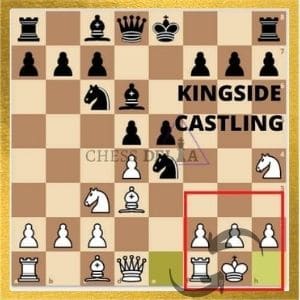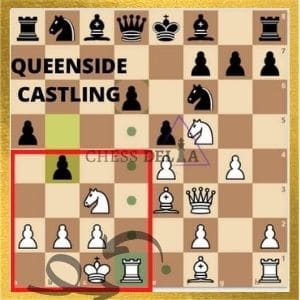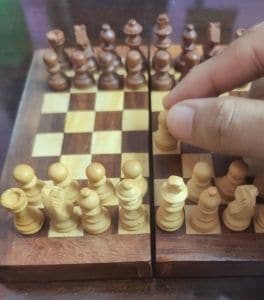Castling is a very special move in chess. It is the only move in chess in which the two pieces king and rook move simultaneously in a single turn.
The king moves two squares on either left or right side of the board and the rook on that side moves just beside the king in castling. There are two ways to castle: One is kingside castling and another is queenside castling.
In this guide, I’ll be explaining to you what is kingside castling, what is queenside castling, the advantages, and disadvantages of both types of castling along with their comparison.
If you read till the end then your all doubts related to both types of castling will be solved. So without further ado, let’s dive in!
Table of Contents
Four Rules Of Castling
But before starting, it is necessary that you know the four rules of castling so let’s discuss that in brief. Always remember, you can castle only if:
- If neither the king nor rook has been moved yet.
- There are no pieces between the king and the rook.
- The king is not in check.
- The squares through which the king is going to pass or the square to be occupied is not under attack.
I have written a complete article on when can you castle in chess. If interested, you can check that out!
What Is Kingside Castling?
In kingside castling, the king moves two squares to the right in the case of white and on the left in the case of black. The rook on that side moves directly to the other side of the king in the same move. Kingside castling is often called a short castle in chess. As per the standard rules, it is denoted by the symbol “0-0”.
Here’s an image that illustrates how to castle kingside:

The kingside castling is known as a short castle because the rook moves a short distance of only two squares.
The trick to remembering this kingside castling notation symbol is to associate the fact of the rook moving only two squares in kingside castling with it.
What is the advantage of Kingside castling?
Following are the advantages of kingside castling:
#1. King is in safer position in kingside castling
Since in kingside castling the king is placed more closely to the edge of the board, it is safe. Moreover, all the pawns are also strong enough to guard the king.
This is not possible in queenside castling because a1 pawn is weak.
You have to spend a tempo for this. This is discussed ahead in this article.
#2. It takes less time to do kingside castling
You can do kingside castling easily after developing your bishop and knight. While in queenside castling it takes a longer time because you have to first develop the knight, bishop, and the queen as well.
Also Read: Can You Castle Out Of Check?
What is the disadvantage of Kingside castling?
Following are the disadvantages of kingside castling:
#1. Rook is placed in a less active position
In kingside castling since the h1 rook is placed on f1 (refer to the above image) This position does not control the center of the chessboard. Hence, the rook is placed in the less active position.
You have to spend a tempo to move one square so that it can control the center. A tempo sometimes proves to be very valuable for you and missing it might cost you a lot.
What Is Queenside Castling?
In queenside castling, the king moves two squares to the left in the case of white and to the right in the case of black. The rook on that side moves directly to the other side of the king in the same move. Queenside castling is often called a long castle in chess. As per the standard rules, it is denoted by the symbol “0-0-0”.
Here’s an image that illustrates how to castle queenside:

The queenside castling is known as a long castle because the rook moves a long distance of three squares.
The trick to remembering this queenside castling notation symbol is to associate the fact of the rook moving only three squares in queenside castling with it.
By the way, if you ever thought of how to castle in chess.com then I recommend you check out my article about it here.
What is the advantage of Queenside castling?
Following are the advantages of queenside castling:
#1. Helps the king to launch into action faster in the endgame
King plays a very active role in the endgame. Queenside castling puts the king more towards the center of the board. This helps you take control of the endgame faster and attack your opponent.
#2. Helps to activate the rook early on
As you can see in the image in queenside castling the a1 rook is placed on d1. This helps to activate your rook and push it into action early.
What is the disadvantage of Queenside castling?
Following are the disadvantages of Queenside castling:
#1. It takes a longer time to achieve queenside castling.
Queenside castling takes a little bit longer time. We have to first develop our bishops, knights, and queen then only we are able to do it.
Since it takes a longer time to first develop our pieces, queenside castling is less common in chess.
#2. King is less safe in queenside castling
When castling queenside king is a little bit closer to the center compared to kingside castling. However Hence queenside castling is safer than kingside castling.
You can see the image of the chessboard positions and imagine what I am talking about, you will surely get it.
Read Related: What Is The Perfect Time To Castle In Chess?
#3. Will lose a tempo
In queenside castling, as you can see in the image the king is nearer to the center of the board. So it is necessary to keep it more to the edge of the board. For that, we have to utilize a tempo (turn).
It is also important to guard the ‘weak pawn’ on ‘a’ file moving the one step more towards the edge. You might be asking me why we should guard the ‘a’ file pawn.
It is because it will be the weak door and a good opportunity for the opponent to break the castle and attack your king from that side. (If you still don’t get me please refer to the image)
In this process, we will utilize a tempo in this process. Losing a tempo sometimes can cost us a lot. So we have to keep that in mind while dealing with queenside castling.
Kingside Vs Queenside Castling
| Kingside Castling | Queenside Castling |
| Faster to achieve | Slower to achieve |
| King is more safe | King is less safe |
| Will not lose a tempo | Will lose a tempo |
| Rook becomes less active | Rook becomes more active |
| Not so helpful for endgame | Helpful for endgame |
When we decide to castle, it happens to most of us that we start to wonder and think about how to decide on which side to castle in chess. So I researched and here’s what I got. Is it better to castle kingside or queenside?
It is better to castle kingside considering the safety of your king and if you want to castle faster. But if the king is already guarded and you want to activate your rook then queenside castling is a better option.
Is it better to castle kingside or queenside?
When we decide on to castle, it happens to most of us that we start to wonder and think about how to decide on which side to castle in chess. So I researched and here’s what I got. Is it better to castle kingside or queenside?
It is better to castle kingside considering the safety of your king and if you want to castle faster. But if the king is already guarded and you want to activate your rook then queenside castling is a better option.
Why kingside castling is better than queenside castling?
Kingside castling is better because it can be achieved faster. It places the king in a very safe position near the edge of the board. Considering the king’s safety it is better than queenside.
However, there may be instances where queenside castling would be a better option.
Also Read: Castling With Two Hands: Is It Illegal? (Explained)
When pieces are traded early on it is better to castle queenside. First of all, you will not only be able to take more control over the center activating your rooks, but also get the benefit from the end game since the king is nearer to the center of the board.
But queenside castling happens very rarely because of the time it takes to achieve. First, you have to develop your pieces including the queen and then only your castle queenside.
What is opposite side castling?
Castling in which both the opponents choose to castle the alternate side of each other. For example, if a player castles kingside then the opponent chooses to castle queenside and vice versa.
This castling gives rise to fierce battles because both players’ pawns are free to move forward and attack each other’s king. Such moves occur in Dragon Variation, Sicilian Defense, and the Yugoslav Attack.
Tip 🙂 – Do you struggle to find out the right way to offer a draw in chess? Then check out my article: Complete Guide: How to offer a draw and how to accept it in chess?
Final Thoughts
I hope that you got all the points. Now finally I am giving you a proper step by step guide or say set of rules which I developed researching castling.
I myself follow these step-by-step guides and suggest that you should also follow them while playing chess. I strongly believe that following this will surely help you and give you an extra edge while castling next time clearing all your confusion. So here it is!
- Castle within the first 5-10 moves, so that your king is safe and you can develop your rook.
- If your opponent hasn’t castled, then look for ways to attack it in the center.
- If you are not castled even after 10 moves then make sure that your king is in a safe position.
- After your castle, make sure you keep your castled position safe.
- Last but not least, Always keep your mind open and evaluate the positions properly then only take any decision.
So that’s it! Hope you liked this article as much as I liked to share it with you. If you find it helpful then please do share this article.
Now that you know everything about which side is best to castle below is a test 🙂 for you! Apply your skills and try to answer the question.
Test Time: From Grandmaster’s game
What do you think will be best, kingside or queenside castling for white?
This is from one of the games played by grandmaster Magnus Carlsen. White is Magnus Carlsen’s chess piece. So what have you thought till now? Will kingside be better at this position for Magnus Carlsen or queenside?
Hoping you have prepared your answer without cheating by scrolling down! So the answer is Queenside!
If you got the right answer, then congrats but if you got wrong then also don’t worry. Analyze where you are evaluated. By the way, if you want you can check that out in a complete video analysis by clicking on the above source.
Now, below there are some of the common and frequently asked questions often asked by beginners. You can check that out, might find something helpful for you. Till then, thanks and have a nice day!
Related Questions:
Can you castle both sides?
Yes, you can castle both kingside and queenside but only one at a time. Also, you need to make sure that the king or the rook has not been moved yet, the king is not in check, there are no pieces between them, and the castling move doesn’t put the king in check.
Can you castle queenside?
Yes, you can castle queenside provided you don’t violate the standard castling rules. You can castle only if the king is not in check, there are no pieces between the king and the rook, the king or rook hasn’t been moved yet and the castling move doesn’t put the king in check.
Can you kingside castle in check?
As per FIDE laws, you cannot castle when you are in check whether it is kingside or queenside. Castling in check, through a check, and into check is illegal in chess.
Can you castle with a queen?
No, you cannot castle with a king. You can only castle with a king and rook only when you follow the rules mentioned by FIDE.
Where does the king go when you castle?
There are two types of castle, kingside, and queenside. The king moves two squares two the right when you castle kingside. While the king moves two squares to the left in queenside castling.
Is Queen side Castle legal?
Queenside castling is legal because it is allowed in the FIDE laws. In fact, both kingside and queenside castling is legal.





